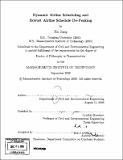| dc.contributor.advisor | Cynthia Barnhart. | en_US |
| dc.contributor.author | Jiang, Hai, 1979- | en_US |
| dc.contributor.other | Massachusetts Institute of Technology. Dept. of Civil and Environmental Engineering. | en_US |
| dc.date.accessioned | 2007-07-18T13:19:37Z | |
| dc.date.available | 2007-07-18T13:19:37Z | |
| dc.date.copyright | 2006 | en_US |
| dc.date.issued | 2006 | en_US |
| dc.identifier.uri | http://hdl.handle.net/1721.1/37976 | |
| dc.description | Thesis (Ph. D.)--Massachusetts Institute of Technology, Dept. of Civil and Environmental Engineering, 2006. | en_US |
| dc.description | Includes bibliographical references (p. 151-156). | en_US |
| dc.description.abstract | Demand stochasticity is a major challenge for the airlines in their quest to produce profit maximizing schedules. Even with an optimized schedule, many flights have empty seats at departure, while others suffer a lack of seats to accommodate passengers who desire to travel. Recognizing that demand forecast quality for a particular departure date improves as the date comes close, we tackle this challenge by developing a dynamic scheduling approach that re-optimizes elements of the flight schedule during the passenger booking period. The goal is to match capacity to demand, given the many operational constraints that restrict possible assignments. We introduce flight re-timing as a dynamic scheduling mechanism and develop a re-optimization model that combines both flight re-timing and flight re-fleeting. Our re-optimization approach, re-designing the flight schedule at regular intervals, utilizes information from both revealed booking data and improved forecasts available at later re-optimizations. Experiments are conducted using data from a major U.S. airline. We demonstrate that significant potential profitability improvements are achievable using this approach. | en_US |
| dc.description.abstract | (cont.) We complement this dynamic re-optimization approach with models and algorithms to de-peak existing hub-and-spoke flight schedules so as to maximize future dynamic scheduling capabilities. In our robust de-peaking approach, we begin by solving a basic de-peaking model to provide a basis for comparison of the robust de-peaked schedule we later generate. We then present our robust de-peaking model to produce a schedule that maximizes the weighted sum of potentially connecting itineraries and attains at least the same profitability as the schedule produced by the basic de-peaking model. We provide several reformulations of the robust de-peaking model and analyze their properties. To address the tractability issue, we construct a restricted model through an approximate treatment of the profitability requirement. The restricted model is solved by a decomposition based solution approach involving a variable reduction technique and a new form of column generation. We demonstrate, through experiments using data from a major U.S. airline, that the schedule generated by our robust de-peaking approach achieves improved profitability. | en_US |
| dc.description.statementofresponsibility | by Hai Jiang. | en_US |
| dc.format.extent | 156 p. | en_US |
| dc.language.iso | eng | en_US |
| dc.publisher | Massachusetts Institute of Technology | en_US |
| dc.rights | M.I.T. theses are protected by copyright. They may be viewed from this source for any purpose, but reproduction or distribution in any format is prohibited without written permission. See provided URL for inquiries about permission. | en_US |
| dc.rights.uri | http://dspace.mit.edu/handle/1721.1/7582 | |
| dc.subject | Civil and Environmental Engineering. | en_US |
| dc.title | Dynamic airline scheduling and robust airline schedule de-peaking | en_US |
| dc.type | Thesis | en_US |
| dc.description.degree | Ph.D. | en_US |
| dc.contributor.department | Massachusetts Institute of Technology. Department of Civil and Environmental Engineering | |
| dc.identifier.oclc | 150437167 | en_US |

